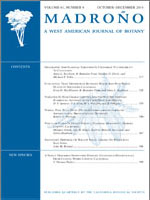Weedy plants may have unique functional traits that distinguish them from other species. We categorized four annual plant species as weedy and five as non-weedy based on their prevalence in disturbed and invaded environments. This designation was tested in a field trial where we scattered equal numbers of viable seeds in 20 different plots and monitored density and cover over three months. The plants a priori designated as weedy had significantly greater cover and densities than species designated as non-weedy. We hypothesized that a suite of functional traits would define the weedy plant habit. We tested this hypothesis by comparing functional traits between weedy and non-weedy plant species. A principal components analysis (PCA) identified three distinct ecological clusters among the analyzed species (weedy forbs, non-weedy forbs, and grasses). The weedy habit was different from the non-weedy habit in several traits (slower growth, heavier diaspores, earlier flowering initiation, and dormant seeds requiring cold-stratification for germination). Weedy annuals in southern California appear to share a suite of traits, suggesting that their success as weeds is linked to adaptive traits. Further understanding of the traits shared among weedy plant species may help screen for native plants that are valuable for ecological restoration of highly invaded landscapes.
How to translate text using browser tools
1 October 2014
Functional Trait Differences Between Weedy And Non-Weedy Plants In Southern California
Evan D. MacKinnon,
R. Brandon Pratt,
Anna L. Jacobsen
ACCESS THE FULL ARTICLE

Madroño
Vol. 61 • No. 4
October 2014
Vol. 61 • No. 4
October 2014
California
functional trait
restoration
weedy plants




